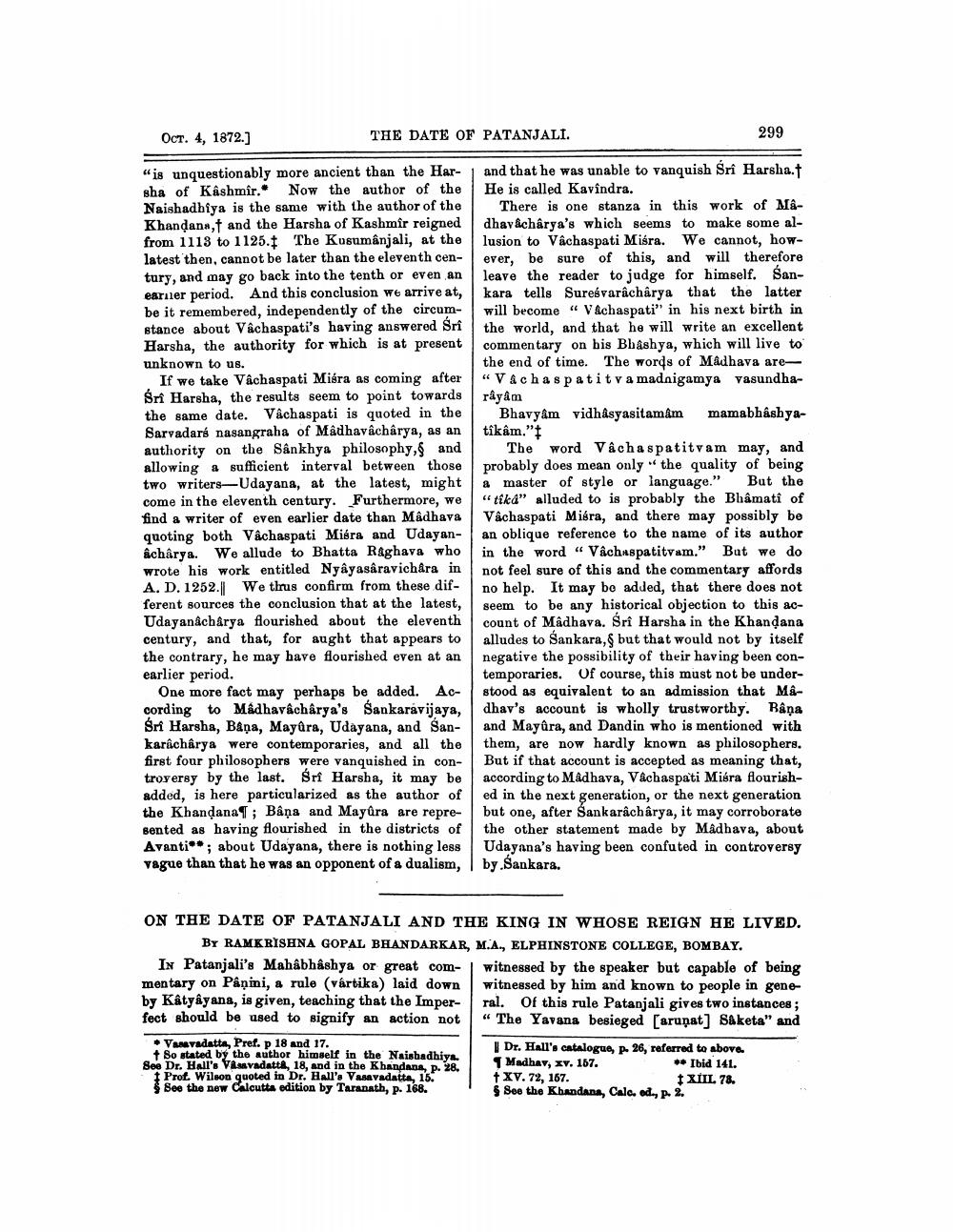________________
Oct. 4, 1872.)
THE DATE OF PATANJALI.
299
“is unquestionably more ancient than the Har- sha of Kashmîr. Now the author of the Naishadhiya is the same with the author of the Khandans, and the Harsha of Kashmir reigned from 1113 to 1125. The Kusumânjali, at the latest then, cannot be later than the eleventh century, and may go back into the tenth or even an earner period. And this conclusion we arrive at, be it remembered, independently of the circumstance about Vâchaspati's having answered Sri Harsha, the authority for which is at present unknown to us.
If we take Vâchaspati Misra as coming after Sri Harsha, the results seem to point towards the same date. Váchaspati is quoted in the Sarvadars nasangraha of Madhavâcharya, as an authority on the Sankhya philosophy, and allowing a sufficient interval between those two writers-Udayana, at the latest, might
ome in the eleventh century. Furthermore, we find a writer of even earlier date than Madhava quoting both Vâchaspati Misra and Udayanâcharya. We allude to Bhatta Raghava who wrote his work entitled Nyâyasâravichara in A. D. 1252. We this confirm from these different sources the conclusion that at the latest, Udayanacharya flourished about the eleventh century, and that, for aught that appears to the contrary, he may have flourished even at an earlier period.
One more fact may perhaps be added. According to Madhavacharya's Sankaravijaya, Sri Harsha, Bana, Mayûra, Udayana, and Sankaracharya were contemporaries, and all the first four philosophers were vanquished in controversy by the last. Sri Harsha, it may be added, is here particularized as the author of the Khandanas; Bâņa and Mayura are represented as having flourished in the districts of Avanti**; about Udayana, there is nothing less vague than that he was an opponent of a dualism,
and that he was unable to vanquish Sri Harsha.t He is called Kavindra.
There is one stanza in this work of Madhavacharya's which seems to make some allusion to Vâchaspati Misra. We cannot, however, be sure of this, and will therefore leave the reader to judge for himself. Sankara tells Sureśvarâcharya that the latter will become “ Vachaspati" in his next birth in the world, and that he will write an excellent commentary on bis Bhashya, which will live to the end of time. The words of Madhava are“V&chas patit va madnigamya vasundharayam
Bhavyâm vidhâsyasitamam mamabhashyatikám."
The word Vâcha spatitvam may, and probably does mean only the quality of being a master of style or language." But the “tika" alluded to is probably the Bhâmatî of Váchaspati Misra, and there may possibly be an oblique reference to the name of its author in the word “ Vâchuspatitvam." But we do not feel sure of this and the commentary affords no help. It may be added, that there does not seem to be any historical objection to this account of Mâdhava. Śrî Harsha in the Khandana alludes to Sankara, but that would not by itself negative the possibility of their having been contemporaries. Of course, this must not be understood as equivalent to an admission that M&dhav's account is wholly trustworthy. Båņa and Mayûra, and Dandin who is mentioned with them, are now hardly known as philosophers. But if that account is accepted as meaning that, according to Madhava, Vachaspati Misra flourished in the next generation, or the next generation but one, after Sankaracharya, it may corroborate the other statement made by Madhava, about Udayana's having been confuted in controversy by Sankara.
ON THE DATE OF PATANJALI AND THE KING IN WHOSE REIGN HE LIVED.
BY RAMKRISHNA GOPAL BHANDARKAR, M.A., ELPHINSTONE COLLEGE, BOMBAY. In Patanjali's Mahâbhâshya or great com- witnessed by the speaker but capable of being mentary on Pâņini, a rule (vártika) laid down witnessed by him and known to people in geneby Katyayana, is given, teaching that the Imper- ral. Of this rule Patanjali gives two instances; fect should be used to signify an action not “The Yavana besieged [aruņat] S&keta" and • Vaanvadatta, Pref. p 18 and 17.
Dr. Hall's catalogue, p. 26, referred to above. So stated by the author himself in the Naishadhiys 8 Dr. Hull's Vilnvadatta, 18, and in the Khandans, D. 28.
Madhav, xv. 167.
** Ibid 141. Prof. Wilson quoted in Dr. Hall's Vasavadatta, 15.
+ XV. 72, 167.
I XIIL 78. See the new Calcutta edition by Taranath, p. 168.
See the Khandans, Calo. ed., p. 2.




